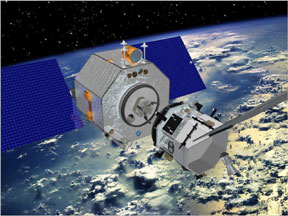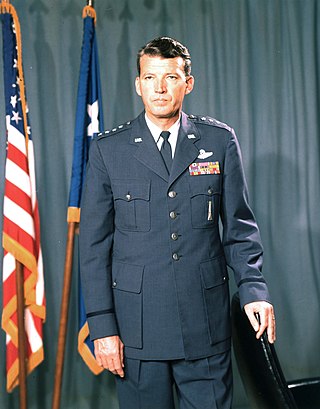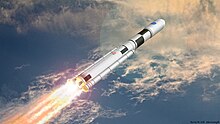
The Strategic Defense Initiative (SDI), derisively nicknamed the "Star Wars program", was a proposed missile defense system intended to protect the United States from attack by ballistic strategic nuclear weapons. The concept was announced on March 23, 1983, by President Ronald Reagan, a vocal critic of the doctrine of mutually assured destruction (MAD), which he described as a "suicide pact". Reagan called upon American scientists and engineers to develop a system that would render nuclear weapons obsolete. Elements of the program reemerged in 2019 with the Space Development Agency (SDA).

An expendable launch system is a launch vehicle that can be launched only once, after which its components are either destroyed during reentry or discarded in space. ELVs typically consist of several rocket stages that are discarded sequentially as their fuel is exhausted and the vehicle gains altitude and speed. As of 2022, most satellites and human spacecraft are currently launched on ELVs. ELVs are simpler in design than reusable launch systems and therefore may have a lower production cost. Furthermore, an ELV can use its entire fuel supply to accelerate its payload, offering greater payloads. ELVs are proven technology in widespread use for many decades.

John Elmer Blaha is a retired United States Air Force colonel and a former NASA astronaut. He is a veteran of five space missions aboard the Space Shuttle and Mir.

The Manned Orbiting Laboratory (MOL) was part of the United States Air Force (USAF) human spaceflight program in the 1960s. The project was developed from early USAF concepts of crewed space stations as reconnaissance satellites, and was a successor to the canceled Boeing X-20 Dyna-Soar military reconnaissance space plane. Plans for the MOL evolved into a single-use laboratory, for which crews would be launched on 30-day missions, and return to Earth using a Gemini B spacecraft derived from NASA's Gemini spacecraft and launched with the laboratory.

Richard Alan Searfoss was an American aviator who was United States Air Force colonel, NASA astronaut and test pilot.

Titan IV was a family of heavy-lift space launch vehicles developed by Martin Marietta and operated by the United States Air Force from 1989 to 2005. Launches were conducted from Cape Canaveral Air Force Station, Florida and Vandenberg Air Force Base, California.
The Aerospace Corporation is an American nonprofit corporation that operates a federally funded research and development center (FFRDC) in El Segundo, California. The corporation provides technical guidance and advice on all aspects of space missions to military, civil, and commercial customers. As the FFRDC for national-security space, Aerospace works closely with organizations such as the United States Space Force and the National Reconnaissance Office (NRO) to provide "objective technical analyses and assessments for space programs that serve the national interest". Although the USSF and NRO are the primary customers, Aerospace also performs work for civil agencies such as NASA and NOAA as well as international organizations and governments in the national interest.

Orbital Express was a space mission managed by the United States Defense Advanced Research Projects Agency (DARPA) and a team led by engineers at NASA's Marshall Space Flight Center (MSFC). The Orbital Express program was aimed at developing "a safe and cost-effective approach to autonomously service satellites in orbit". The system consisted of two spacecraft: the ASTRO servicing satellite, and a prototype modular next-generation serviceable satellite; NEXTSat. The mission launched from Cape Canaveral Air Force Station on 8 March 2007, aboard an Atlas V expendable launch vehicle. The launch was part of the United States Air Force Space Test Program STP-1 mission.
Criticism of the Space Shuttle program stemmed from claims that NASA's Space Shuttle program failed to achieve its promised cost and utility goals, as well as design, cost, management, and safety issues. Fundamentally, it failed in the goal of reducing the cost of space access. Space Shuttle incremental per-pound launch costs ultimately turned out to be considerably higher than those of expendable launchers. By 2011, the incremental cost per flight of the Space Shuttle was estimated at $450 million, or $18,000 per kilogram to low Earth orbit (LEO). In contrast, the comparable Proton launch vehicle is said to cost as little as $110 million, or around $5,000 per kilogram to LEO, despite not being reusable.

The ASM-135 ASAT is an air-launched anti-satellite multistage missile that was developed by Ling-Temco-Vought's LTV Aerospace division. The ASM-135 was carried exclusively by United States Air Force (USAF) F-15 Eagle fighter aircraft.
The Space Test Program (STP) is the primary provider of spaceflight for the United States Department of Defense (DoD) space science and technology community. STP is managed by a group within the Advanced Systems and Development Directorate, a directorate of the Space and Missile Systems Center of the United States Space Force. STP provides spaceflight via the International Space Station (ISS), piggybacks, secondary payloads and dedicated launch services.

Space Systems Command (SSC) is the United States Space Force's space development, acquisition, launch, and logistics field command. It is headquartered at Los Angeles Air Force Base, California and manages the United States' space launch ranges.
Jarvis was a proposed American medium-lift launch vehicle for space launch, designed by Hughes Aircraft and Boeing during the mid-1980s as part of the joint United States Air Force (USAF)/National Aeronautics and Space Administration (NASA) Advanced Launch System (ALS) study. Intended to utilize engines and tooling in storage from the Saturn V rocket program along with Space Shuttle components, and projected to be capable of carrying up to six satellites into multiple orbits using a single launch, the proposal failed to meet the ALS requirements, and the Jarvis rocket was never built.

The Space Launch Initiative (SLI) was a NASA and U.S. Department of Defense joint research and technology project to determine the requirements to meet all the nation's hypersonics, space launch and space technology needs. It was also known as the second generation Reusable Launch Vehicle program, after the failure of the first. The program began with the award of RLV study contracts in 2000.

The 1st Space Operations Squadron is a United States Space Force unit responsible for space-based space domain awareness. Located at Schriever Space Force Base, Colorado, the squadron operates the Space Based Space Surveillance system, the Advanced Technology Risk Reduction system, the Operationally Responsive Space-5 satellite, and the Geosynchronous Space Situational Awareness Program.
SpaceWorks Enterprises, Inc. (SEI) is an aerospace engineering company based in Atlanta, Georgia, United States that specializes in the design, assessment, hardware prototyping and flight demonstration of advanced space concepts for both government and commercial customers.
The DARPA XS-1 was an experimental spaceplane/booster with the planned capability to deliver small satellites into orbit for the U.S. Military. It was reported to be designed to be reusable as frequently as once a day, with a stated goal of doing so for 10 days straight. The XS-1 was intended to directly replace the first stage of a multistage rocket by taking off vertically and flying to hypersonic speed and high suborbital altitude, enabling one or more expendable upper stages to separate and deploy a payload into low Earth orbit. The XS-1 would then return to Earth, where it could ostensibly be serviced fast enough to repeat the process at least once every 24 hours.
Northrop Grumman Innovation Systems (NGIS) was a sector of Northrop Grumman from 2018 through 2019. It was formed from Orbital ATK Inc. a company which resulted from the merger of Orbital Sciences Corporation and parts of Alliant Techsystems in 2015. Orbital ATK was purchased by Northrop Grumman in 2018. Northrop Grumman Innovation Systems designed, built, and delivered space, defense, and aviation-related systems to customers around the world both as a prime contractor and as a merchant supplier. It had a workforce of approximately 12,000 employees dedicated to aerospace and defense including about 4,000 engineers and scientists; 7,000 manufacturing and operations specialists; and 1,000 management and administration personnel. With Northrop Grumman's reorganization of its divisions effective January 1, 2020, NGIS was split, with most of the sector merging with other Northrop Grumman businesses into a new Space Systems sector.

Shuttle-Centaur was a version of the Centaur upper stage rocket designed to be carried aloft inside the Space Shuttle and used to launch satellites into high Earth orbits or probes into deep space. Two variants were developed: Centaur G-Prime, which was planned to launch the Galileo and Ulysses robotic probes to Jupiter, and Centaur G, a shortened version planned for use with United States Department of Defense Milstar satellites and the Magellan Venus probe. The powerful Centaur upper stage allowed for heavier deep space probes, and for them to reach Jupiter sooner, prolonging the operational life of the spacecraft. However, neither variant ever flew on a Shuttle. Support for the project came from the United States Air Force (USAF) and the National Reconnaissance Office, which asserted that its classified satellites required the power of Centaur. The USAF agreed to pay half the design and development costs of Centaur G, and the National Aeronautics and Space Administration (NASA) paid the other half.

While the United States Space Force gained its independence on 20 December 2019, the history of the United States Space Force can be traced back to the beginnings of the military space program following the conclusion of the Second World War in 1945. Early military space development was begun within the United States Army Air Forces by General Henry H. Arnold, who identified space as a crucial military arena decades before the first spaceflight. Gaining its independence from the Army on 18 September 1947, the United States Air Force began development of military space and ballistic missile programs, while also competing with the United States Army and United States Navy for the space mission.













